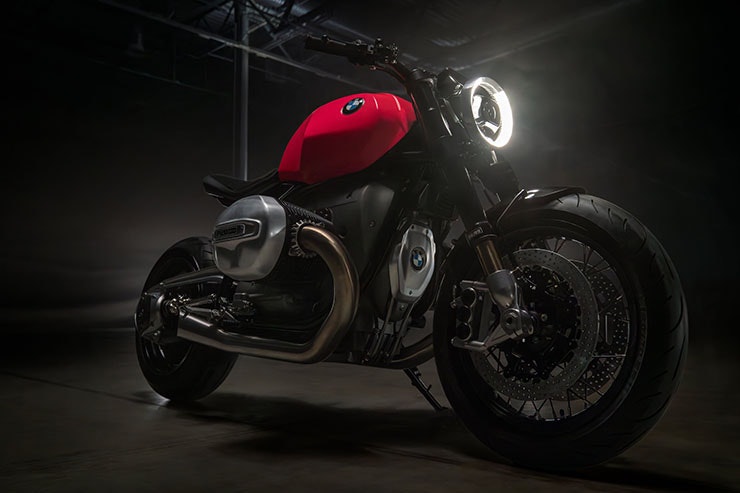BMW R20 Concept - monstrous new retro model
By Ben Purvis
Motorcycle Journalist
24.05.2024
Officially the new BMW R20 is a ‘concept’ to wow the crowds at the Villa d’Este concours event but don’t let that fool you – it’s a lightly-disguised version of an upcoming production model based around the vast air-cooled boxer twin from the R18 cruiser.
You only have to look at the history of the concepts shown at previous Villa d’Este events to see how the story plays out. As long ago as 2013 BMW showed the Concept 90 at Villa d’Este, two years before the R NineT hit the market. In 2014 there was the Concept Roadster, which was productionised as the 2015-spec R1200R. In 2015 the Concept 101 previewed the K1600B, in 2017 the Concept Link gave an early look at the CE 04 electric scooter. The 2018 Concept 9cento turned into the F900XR and in 2019 the Concept R18 showed us the R18 before it was confirmed for production.
In short, when BMW uses the word ‘concept’ with a show bike, it means ‘this will be in showrooms very soon.’ For design studies that aren’t production-bound, the company tends to use terms like ‘Hommage’ as on the R5 Hommage or ‘Vision’ like the Vision DC or Vision Amby. The R20 is dubbed ‘concept’ – so we can be pretty sure there’s a production version heading our way in 2025 or 2026.
What, then, is the R20? Well, it’s essentially the result of taking BMW’s biggest-ever motorcycle engine – the R18’s 1802cc air-cooled boxer twin – and shoehorning it into a much smaller, lighter and more agile bike. Oh, and while they were at it BMW’s boffins decided to up the engine’s size another notch to reach a nice, round 2000cc. BMW’s new Head of Motorrad, Markus Flasch – who previously headed the company’s ‘M’ division – calls it a “mechanical masterpiece” but essentially it’s taking the same idea that created over-engined classics like the Shelby Cobra and applying it to two wheels.
In the process, BMW developed new cylinder head covers, a new belt cover and a new oil cooler to help clean up the engine’s appearance, as it’s extremely exposed in its new, undersized home, creating an appealing, caricature look to the bike – the eye can’t fail to be drawn to those vast cylinders.
It’s a look that’s emphasised by a completely new chassis, still made of steel tubes but shrink-wrapped around the engine to make the bike as small as it can be. The wheelbase, 1550mm, isn’t superbike-short – it’s the same as an Africa Twin Adventure Sports – but it’s nearly 20cm shorter than the R18 and promises much quicker steering than any 2-litre bike has a right to. Sensibly-sized wheels – 120/70-17 front and 200/55-17 rear – mean handling isn’t being sacrificed on the altar of appearance either. The rake is set at 27.5 degrees, which should give a good compromise between steering speed and stability, with upside-down, fully-adjustable Ohlins Blackline forks. Those are matched by a similarly-tweakable rear shock on an unusual-looking new version of BMW’s Paralever rear suspension system with the lower swingarm section made of steel and the upper link that runs parallel to it cast from aluminium. Like the R8, the drive shaft and its universal joint are openly on display, although the production version will inevitably gain some heftier silencers that might hide it from view.
The concept’s front brakes are six-pot ISR calipers, radially mounted and paired with a four-pot rear caliper.
The bike’s styling is as minimalistic as its engine is vast. The tank, made of aluminium to help save weight, harks back to earlier BMWs and more modern retro machines like the R nineT, and sits behind an LED headlight that ‘floats’ inside a larger ring of DRLs, giving the classic proportions of a big, round lamp while using modern technology and styling ideas. A pared-back digital display shows revs, speed and gear, but little else.
Behind the tank there’s a single seat that’s designed to maximise the visual space between it and the rear wheel. It’s an element that’s likely to be tweaked for production, not only because there’s sure to be a demand for a subframe to cope with passengers and luggage, but because road homologation rules require bodywork to extend behind the rear edge of the back tyre (a swingarm-mounted licence plate bracket would achieve that, though).
Some information has yet to be released. How much power and torque the big, 2000cc twin manages, for example. The R18’s 1802cc version is good for a modest 91hp at a low 4750rpm and a whopping 116lb-ft of torque at just 3000rpm. More capacity for the R20 means both numbers are likely to rise, with something close to 130lb-ft on the cards and, depending on the state of tune, a power figure well north of 100hp easily within reach.
When can we expect it in showrooms? 2026 seems a good bet going by the progress that previous BMW Villa d’Este concepts have made.
If you’d like to chat about this article or anything else biking related, join us and thousands of other riders at the Bennetts BikeSocial Facebook page.
Share on social media:
